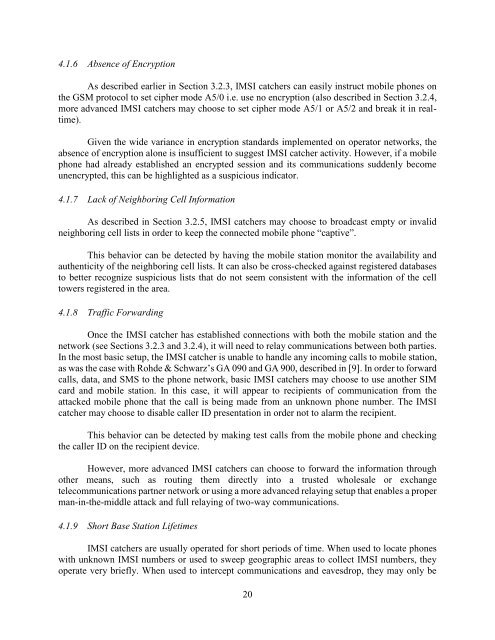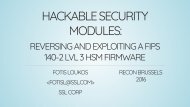IMSI Catchers and Mobile Security
EAS499Honors-IMSICatchersandMobileSecurity-V18F-1
EAS499Honors-IMSICatchersandMobileSecurity-V18F-1
You also want an ePaper? Increase the reach of your titles
YUMPU automatically turns print PDFs into web optimized ePapers that Google loves.
4.1.6 Absence of Encryption<br />
As described earlier in Section 3.2.3, <strong>IMSI</strong> catchers can easily instruct mobile phones on<br />
the GSM protocol to set cipher mode A5/0 i.e. use no encryption (also described in Section 3.2.4,<br />
more advanced <strong>IMSI</strong> catchers may choose to set cipher mode A5/1 or A5/2 <strong>and</strong> break it in realtime).<br />
Given the wide variance in encryption st<strong>and</strong>ards implemented on operator networks, the<br />
absence of encryption alone is insufficient to suggest <strong>IMSI</strong> catcher activity. However, if a mobile<br />
phone had already established an encrypted session <strong>and</strong> its communications suddenly become<br />
unencrypted, this can be highlighted as a suspicious indicator.<br />
4.1.7 Lack of Neighboring Cell Information<br />
As described in Section 3.2.5, <strong>IMSI</strong> catchers may choose to broadcast empty or invalid<br />
neighboring cell lists in order to keep the connected mobile phone “captive”.<br />
This behavior can be detected by having the mobile station monitor the availability <strong>and</strong><br />
authenticity of the neighboring cell lists. It can also be cross-checked against registered databases<br />
to better recognize suspicious lists that do not seem consistent with the information of the cell<br />
towers registered in the area.<br />
4.1.8 Traffic Forwarding<br />
Once the <strong>IMSI</strong> catcher has established connections with both the mobile station <strong>and</strong> the<br />
network (see Sections 3.2.3 <strong>and</strong> 3.2.4), it will need to relay communications between both parties.<br />
In the most basic setup, the <strong>IMSI</strong> catcher is unable to h<strong>and</strong>le any incoming calls to mobile station,<br />
as was the case with Rohde & Schwarz’s GA 090 <strong>and</strong> GA 900, described in [9]. In order to forward<br />
calls, data, <strong>and</strong> SMS to the phone network, basic <strong>IMSI</strong> catchers may choose to use another SIM<br />
card <strong>and</strong> mobile station. In this case, it will appear to recipients of communication from the<br />
attacked mobile phone that the call is being made from an unknown phone number. The <strong>IMSI</strong><br />
catcher may choose to disable caller ID presentation in order not to alarm the recipient.<br />
This behavior can be detected by making test calls from the mobile phone <strong>and</strong> checking<br />
the caller ID on the recipient device.<br />
However, more advanced <strong>IMSI</strong> catchers can choose to forward the information through<br />
other means, such as routing them directly into a trusted wholesale or exchange<br />
telecommunications partner network or using a more advanced relaying setup that enables a proper<br />
man-in-the-middle attack <strong>and</strong> full relaying of two-way communications.<br />
4.1.9 Short Base Station Lifetimes<br />
<strong>IMSI</strong> catchers are usually operated for short periods of time. When used to locate phones<br />
with unknown <strong>IMSI</strong> numbers or used to sweep geographic areas to collect <strong>IMSI</strong> numbers, they<br />
operate very briefly. When used to intercept communications <strong>and</strong> eavesdrop, they may only be<br />
20



